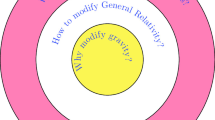Abstract
In classical texts equations for gravitation and electromagnetic fields are proposed without deriving their right-hand sides [1–4]. In this paper, we derive the right-hand sides and analyze the energy–momentum tensor in the framework of Vlasov–Maxwell–Einstein equations and Milne–McCrea models. New models of accelerated expansion of the Universe without Einstein’s lambda are proposed.
Similar content being viewed by others
REFERENCES
V. A. Fock, The Theory of Space, Time, and Gravitation (Pergamon, Oxford, 1964).
B. A. Dubrovin, A. T. Fomenko, and S. P. Novikov, Modern Geometry: Methods and Applications (Springer-Verlag, New York, 1984, 1985, 1990).
Y. Choquet-Bruhat, Introduction to General Relativity, Black Holes and Cosmology (Oxford Univ. Press, New York, 2015).
C. Cercignani and G. M. Kremer, The Relativistic Boltzmann Equation: Theory and Applications (Birkhäuser, Boston, 2002).
V. V. Vedenyapin and M. A. Negmatov, “Derivation and classification of Vlasov-type and magnetohydrodynamics equations: Lagrange identity and Godunov’s form,” Theor. Math. Phys. 170 (3), 394–405 (2012).
V. V. Vedenyapin, M. A. Negmatov, and N. N. Fimin, “Vlasov-type and Liouville-type equations, their microscopic, energetic, and hydrodynamical consequences,” Izv. Math. 81 (3), 505–541 (2017).
V. V. Vedenyapin and M. A. Negmatov, “On derivation and classification of Vlasov type equations and equations of magnetohydrodynamics: The Lagrange identity, the Godunov form, and critical mass,” J. Math. Sci. 202, 769–782 (2014).
V. V. Vedenyapin and M. A. Negmatov, “On the topology of steady-state solutions of hydrodynamic and vortex consequences of the Vlasov equation and the Hamilton–Jacobi method,” Dokl. Math. 87 (2), 240–244 (2013).
V. V. Vedenyapin, M. Yu. Voronina, and A. A. Russkov, “Derivation of the equations of electrodynamics and gravitation from the principle of least action,” Dokl. Phys. 65 (12), 413–417 (2020).
Ye. Huanchun and P. Morrison, “Action principles for the Vlasov equations,” Phys. Fluids 4 (4), 771–777 (1992).
G. Rein and A. D. Rendall, “Smooth static solutions of the spherically symmetric Vlasov–Einstein system,” Ann. Inst. H. Poincaré Phys. Theor. 59, 383–397 (1993).
H. E. Kandrup and P. J. Morrison, “Hamiltonian structure of the Vlasov–Einstein system and the problem of stability for spherical relativistic star clusters,” Ann. Phys. 225, 114–166 (1993).
F. Pegoraro, F. Califano, G. Manfredi, and P. J. Morrison, “Theory and applications of the Vlasov equation,” Eur. Phys. J. D 69, 68 (2015).
T. Okabe, P. J. Morrison, J. E. Friedrichsen III, and L. C. Shepley, “Hamiltonian dynamics of spatially-homogeneous Vlasov–Einstein systems,” Phys. Rev. D 84, 024011 (2011).
A. J. Brizard, P. J. Morrison, J. W. Burby, L. de Guillebon, and M. Vittot, “Lifting of the Vlasov–Maxwell bracket by Lie-transform method,” J. Plasma Phys. 82, 905820608 (2016). https://doi.org/10.48550/arXiv.1606.06652
E. Madelung, “Quantentheorie in hydrodynamischer form,” Z. Phys. 40, 322–326 (1926).
V. V. Kozlov, “The hydrodynamics of Hamiltonian systems,” Moscow Univ. Mech. Bull. 38 (6), 9–23 (1983).
V. V. Kozlov, General Theory of Vortices (Udmurt. Univ., Izhevsk, 1998) [in Russian].
V. V. Vedenyapin, N. N. Fimin, and V. M. Chechetkin, “The generalized Friedmann model as a self-similar solution of Vlasov–Poisson equation system,” Eur. Phys. J. Plus 136, 670 (2021).
V. V. Vedenyapin, V. I. Parenkina, and S. R. Svir-shchevskii, “Derivation of the equations of electrodynamics and gravity from the principle of least action,” Comput. Math. Math. Phys. 62 (6), 983–995 (2022).
V. V. Vedenyapin, “On derivation of equations of electrodynamics and gravitation from the principle of least action, the Hamilton–Jacobi method, and cosmological solutions,” Dokl. Math. 105 (3), 178–182 (2022).
W. H. McCrea and E. A. Milne, “Newtonian universes and the curvature of space,” Q. J. Math. 5, 73–80 (1934).
Yu. N. Orlov and I. P. Pavlotsky, “BBGKY-hierarchies and Vlasov’s equations in postgalilean approximation,” Physica A 151, 318 (1988).
A. D. Chernin, “Dark energy and universal antigravitation,” Phys.-Usp. 51 (3), 253–282 (2008).
S. Capozziello and V. G. Gurzadyan, “Focus point on tensions in cosmology from early to late universe: The value of the Hubble constant and the question of dark energy,” Eur. Phys. J. Plus 138, 184 (2023).
Funding
This work was supported by ongoing institutional funding. No additional grants to carry out or direct this particular research were obtained.
Author information
Authors and Affiliations
Corresponding author
Ethics declarations
The author of this work declares that he has no conflicts of interest.
Additional information
Translated by I. Ruzanova
Publisher’s Note.
Pleiades Publishing remains neutral with regard to jurisdictional claims in published maps and institutional affiliations.
Rights and permissions
About this article
Cite this article
Vedenyapin, V.V. On Derivation of Vlasov–Maxwell–Einstein Equations from the Principle of Least Action, the Hamilton–Jacobi Method, and the Milne–McCrea Model. Dokl. Math. (2024). https://doi.org/10.1134/S1064562424701692
Received:
Revised:
Accepted:
Published:
DOI: https://doi.org/10.1134/S1064562424701692




